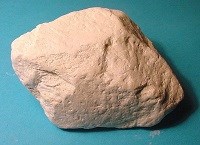This Earth Cache is about the mineral Kaolinite and is located near Albertinia in the Western Cape.
EDUCATIONAL LOGGING REQUIREMENTS
In order to substantiate your visit and comply with the educational requirement for Earth Caches you have to submit your answers to the following questions to the cache developers via their profile:
For purposes of logging this cache you must answer the following four questions.
TO LOG THIS CACHE AND QUALIFY you need to answer the following questions in an email to the cache owner via our profile on the geocaching website. Any logs not accompanied by an email will be deleted.
1) At GZ there is pile of Kaolinite that has been through the crusher. Grab a handful and describe the texture.
2) What is the colour of this kaolin? What other colours could it be?
3) What elements make up this mineral?
4) Pictures would be good but are not a requirement.
|
Kaolinite is a clay mineral, with a soft consistency and earthy texture. It is easily broken and can be molded or shaped, especially when wet. Kaolinite is a lackluster and uninteresting mineral on its own, but it occasionally forms interesting pseudomorphs, especially after feldspars. It is also a common accessory to other minerals, including gem crystals in decomposing feldspar pegmatites.
 The term Kaolinite describes the name of a group of closely-related clay minerals, as well as an individual member mineral of the group. The members of the Kaolinite group all have the same (or similar) chemical formula, and they are Dickite, Kaolinite, Nacrite, Halloysite, and Odinite. Kaolinite also has a very similar chemical formula to Serpentine, and is sometimes considered a member of the Serpentine group. Kaolinite is the most common clay mineral, and entire clay deposits can be composed of this mineral.
The term Kaolinite describes the name of a group of closely-related clay minerals, as well as an individual member mineral of the group. The members of the Kaolinite group all have the same (or similar) chemical formula, and they are Dickite, Kaolinite, Nacrite, Halloysite, and Odinite. Kaolinite also has a very similar chemical formula to Serpentine, and is sometimes considered a member of the Serpentine group. Kaolinite is the most common clay mineral, and entire clay deposits can be composed of this mineral.
There are many commercial Kaolinite mines where this mineral is mined in large volumes for its various industrial uses. Kaolinite is named after the Kao-ling, a mountain in Jiangxi Province in China where this mineral was well-known from early times.
The chemical formula for kaolinite as used in mineralogy is Al2Si2O5(OH)4.
Composition:
| |
Aluminum 20.90 % Al 39.50 % Al2O3 |
| |
Silicon 21.76 % Si 46.55 % SiO2 |
| |
Hydrogen 1.56 % H 13.96 % H2O |
| |
Oxygen 55.78 % O |
| |
______ ______ |
| |
100.00 % 100.00 % = TOTAL OXIDE |
The largest use is in the production of paper, including ensuring the gloss on some grades of paper. Kaolin is also used (or was used in the past) in ceramics (it is generally the main component in porcelain), toothpaste, incandescent light bulbs, cosmetics, in organic farming, as a spray applied to crops to deter insect damage, adsorbents in water and wastewater treatment and to to induce blood clotting in diagnostic procedures.
Kaolin is mined in open cast mines in the Albertinia. Unfortunately they are on private property and are not accessible. The Kaolinite has a distinctive yellow colour in this area. Most kaolinites are coloured pink-orange-red by iron oxide, giving it a distinct rust hue. Lighter concentrations yield white, yellow or light orange colours.
Bear in mind that the pile you see has been through a crusher. There are un-crushed rocks on the Northern side of the area but these might not be accessible if the crusher is in operation.
References:
Minerals.net
Wikipedia